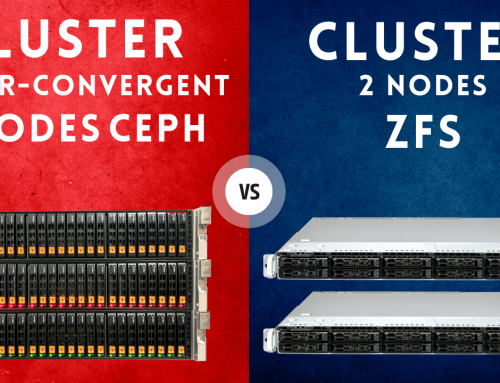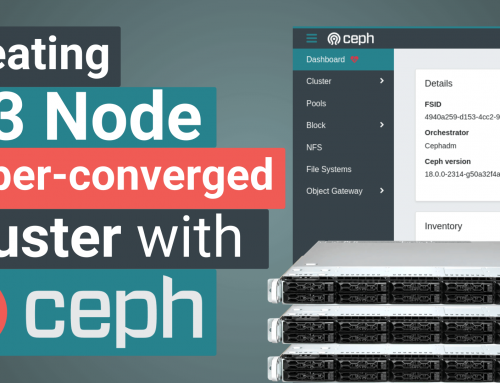Proxmox Virtual Environment is the complete open-source enterprise virtualization solution that integrates KVM hypervisors, LXC containers, storage and networking capabilities on a single platform.
Having recently reached version 6, Proxmox Virtual Environment is growing a lot both in terms of quantity and quality of the features introduced with an eye always very attentive to ease of use and GDPR compliances.
With the integrated web interface you can easily manage:
VMs and containers
manage storage and networking features
high availability clusters
backup and restore,
live migration
VM replica
firewalls
Proxmox Virtual Environment allows you to virtualize even the most demanding Linux and Windows application workloads.
By combining two virtualization technologies, Proxmox Virtual Environment offers maximum flexibility to your virtual IT environment.
By natively integrating support for high availability (HA) and thanks to the unique multi-master design, an additional management server is not required, saving resources and enabling high availability without a single point of failure (SPOF).
Live / online migration of Proxmox Virtual Environment
With the built-in live/online migration feature, you can move running virtual machines from one Proxmox Virtual Environment cluster node to another without any downtime or noticeable effects from the end-user side.
Administrators can initiate this process via script or with the web interface, making it a simple process.
It allows you to easily take a VM offline for maintenance or updates.
Enterprise-ready
Proxmox Virtual Environment represents a powerful yet easy-to-use solution capable of managing standalone nodes or hyper-converged cluster solutions.
It supports different authentication sources and role-based user and permission management allowing full control of HA clusters.
REST APIs allow for easy integration with third-party management tools such as custom hosting environments.
The open source development model guarantees interested users of the Proxmox Virtual Environment full access to the source code as well as maximum flexibility and security.
The numbers of Proxmox Virtual Environment
The Proxmox Virtual Environment open source project has over 270,000 active hosts, the GUI interface is translated into 19 languages, and more than 40,000 members are active in the free community support forum.
Tens of thousands of customers regardless of sector, size or industry type rely on a Proxmox Virtual Environment support subscription, a service offered by Proxmox Server Solutions GmbH.
Industry-leading virtualization technology
- It supports all the best Linux distros, Windows Server and Client, Free BSD, etc… 32 and 64 bit operating systems
Support for the latest Intel and AMD server chipsets for outstanding VM performance
Leading bare metal performance for enterprise workloads
It natively contains all the features needed to create and manage a virtual infrastructure
Open Source Software
- Released under the free and open source GNU Affero General Public License, version 3 (AGPL, V3: http://www.gnu.org/licenses/agpl-3.0)
Designed to ensure cooperation with the community
Public Code Repository (GIT)
Bugtracker for tracking problems
Free support via community forum
Abundant Online Documentation, Wiki, Video Tutorials, Tutorials, …
API Web
- Easy integration for 3rd party management tools like custom hosting environments
REST as API (JSON as primary data format and the whole API is formally defined using JSON Schema)
Easy and human readable data format (native web browser format)
Automatic parameter check (check of return values)
Automatic generation of API documentation
An easy way to build command line tools (use the same API)
Resource Oriented Architecture (ROA)
Defining the declarative API using JSON schema
High availability clusters
- No single point of failure (no SPOF).
Mulit-master cluster (no single master)
GUI managing for HA management
pmxcfs-Proxmox VE Cluster File System: Database-driven file system for storing configuration files replicated in real time to all nodes via Corosync
Based on proven Linux HA technologies, it provides stable and reliable HA service
Resource agents for KVM and Linux Containers (LXC)
Watchdog-based Fencing
Integrated web-based management GUI
- No need to install management tools or additional management node
Fast interface with search capabilities, capable of handling thousands of VMs
Wizard creation of virtual servers and containers
Seamless integration, creation and management of the Cluster directly from the GUI
Management of user creation and permissions via GUI
Role-based permission management for all objects (VM and CT, vaults, etc.)
Support for multiple authentication sources (e.g. local, MS ADS, LDAP, …)
Possibility to activate MFA (Multi Factor Authenticator) for GUI access
AJAX technologies for dynamic resource updates
Based on the Ext JS JavaScript framework.
Cluster-wide activity log: The GUI shows all running activities of the entire cluster, history and syslog of each node. This includes backup or restore jobs, live migration and HA activities. - GDPR Compliant
Live Migration
- In Cluster configuration it is possible to move virtual servers from one physical host to another without downtime (Live Migration) both in Chep configuration and without Ceph
Command line interface
- For expert users
Manage all components of your virtual environment
CLI with smart tab completion and full UNIX man page documentation
Storage Types
- Local storage, ZFS (with encryption support), LVM, LVMthin, ext4 and XFS
Shared storage such as FC, iSCSI and NFS
Distributed storage such as Ceph RBD, CephFS and GlusterFS
Encryption support for Ceph OSD and ZFS
Unlimited number of connected archives (cluster-wide)
Virtualized Networking
- Bridged network model
Each host supports up to 4094 bridges
TCP/IP configuration
IPv4 and IPv6 support
VLANs
Open vSwitch
Backup and restore
- Complete backups of containers and VMs
Live Snapshot Backup
Support for multiple schedules and backup archives
GUI integrations, but also via CLI
“Run now” key and restore via GUI
All jobs from all nodes can be monitored via the centralized GUI tab
Proxmox VE Firewall
- Linux based netfilter technology. Stateful firewalls. Provides broadband.
Distributed: Main configuration in Proxmo VE cluster file system, iptable rules stored in nodes
It supports IPv4 and IPv6
Cluster-level settings
3 levels of configuration (datacenter, host, VM / CT)
Fully customizable allowing complex configurations via GUI or CLI
Quick setup with predefined macros
Multiple sources of authentication
- Proxmox VE supports multiple authentication sources
Standard Linux PAM authentication (e.g. ‘Root’ and other local users)
Proxmox VE authentication server (integrated)
Microsoft Active Directory (MSADS)
LDAP extension
Role-based administration
- User and permission management for all objects (VMs, storages, nodes, etc.)
A role is simply a list of privileges. Proxmox Virtual Environment comes with a number of predefined roles that suit most needs. The full set of predefined roles can be viewed on the GUI.
Permissions are the way to control access to objects. Each permission specifies an entity (user or group) and a role (set of privileges) on a specific path.
VM Models and clones
- Deploying VMs from templates is fast, very convenient, and if you are using linked clones you can optimize storage space using base images and thin-provisioning.
Two-factor authentication
To maximize security
2 types: Time-based One Time Passwords and YubiKey

